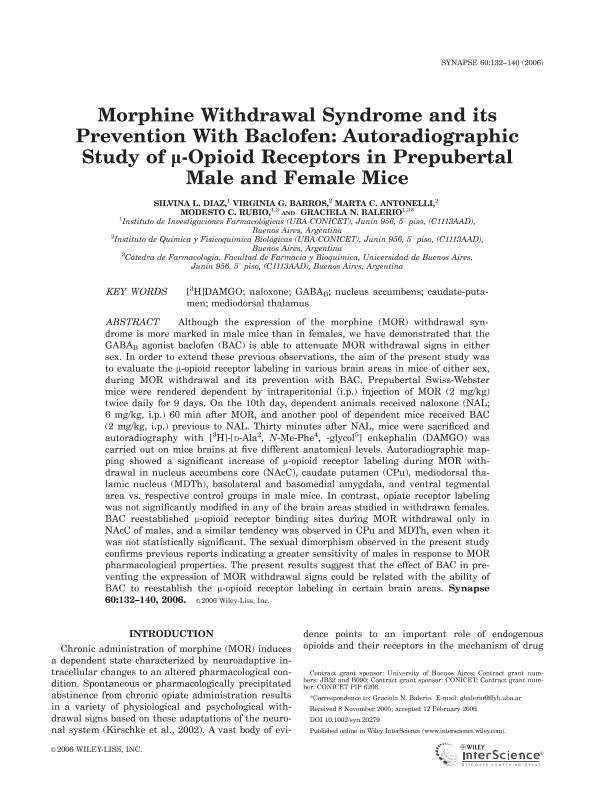Artículo
Morphine withdrawal syndrome and its prevention with baclofen: Autoradiographic study of μ‐opioid receptors in prepubertal male and female mice
Diaz, Silvina Laura ; Barros, Virginia Gabriela
; Barros, Virginia Gabriela ; Antonelli, Marta Cristina
; Antonelli, Marta Cristina ; Rubio, Modesto Carlos
; Rubio, Modesto Carlos ; Balerio, Graciela Noemí
; Balerio, Graciela Noemí
 ; Barros, Virginia Gabriela
; Barros, Virginia Gabriela ; Antonelli, Marta Cristina
; Antonelli, Marta Cristina ; Rubio, Modesto Carlos
; Rubio, Modesto Carlos ; Balerio, Graciela Noemí
; Balerio, Graciela Noemí
Fecha de publicación:
07/2006
Editorial:
Wiley-liss, Div John Wiley & Sons Inc
Revista:
Synapse
ISSN:
0887-4476
Idioma:
Inglés
Tipo de recurso:
Artículo publicado
Clasificación temática:
Resumen
Although the expression of the morphine (MOR) withdrawal syndrome is more marked in male mice than in females, we have demonstrated that the GABAB agonist baclofen (BAC) is able to attenuate MOR withdrawal signs in either sex. In order to extend these previous observations, the aim of the present study was to evaluate the μ‐opioid receptor labeling in various brain areas in mice of either sex, during MOR withdrawal and its prevention with BAC. Prepubertal Swiss‐Webster mice were rendered dependent by intraperitonial (i.p.) injection of MOR (2 mg/kg) twice daily for 9 days. On the 10th day, dependent animals received naloxone (NAL; 6 mg/kg, i.p.) 60 min after MOR, and another pool of dependent mice received BAC (2 mg/kg, i.p.) previous to NAL. Thirty minutes after NAL, mice were sacrificed and autoradiography with [3H]‐[D‐Ala2, N‐Me‐Phe4, ‐glycol5] enkephalin (DAMGO) was carried out on mice brains at five different anatomical levels. Autoradiographic mapping showed a significant increase of μ‐opioid receptor labeling during MOR withdrawal in nucleus accumbens core (NAcC), caudate putamen (CPu), mediodorsal thalamic nucleus (MDTh), basolateral and basomedial amygdala, and ventral tegmental area vs. respective control groups in male mice. In contrast, opiate receptor labeling was not significantly modified in any of the brain areas studied in withdrawn females. BAC reestablished μ‐opioid receptor binding sites during MOR withdrawal only in NAcC of males, and a similar tendency was observed in CPu and MDTh, even when it was not statistically significant. The sexual dimorphism observed in the present study confirms previous reports indicating a greater sensitivity of males in response to MOR pharmacological properties. The present results suggest that the effect of BAC in preventing the expression of MOR withdrawal signs could be related with the ability of BAC to reestablish the μ‐opioid receptor labeling in certain brain areas.
Palabras clave:
[3H]DAMGO
,
CAUDATE-PUTAMEN
,
GABAB
,
MEDIODORSAL THALAMUS
,
NALOXONE
,
NUCLEUS ACCUMBENS
Archivos asociados
Licencia
Identificadores
Colecciones
Articulos(IBCN)
Articulos de INST.DE BIOLO.CEL.Y NEURCS."PROF.E.DE ROBERTIS"
Articulos de INST.DE BIOLO.CEL.Y NEURCS."PROF.E.DE ROBERTIS"
Articulos(ININFA)
Articulos de INST.DE INVEST.FARMACOLOGICAS (I)
Articulos de INST.DE INVEST.FARMACOLOGICAS (I)
Citación
Diaz, Silvina Laura; Barros, Virginia Gabriela; Antonelli, Marta Cristina; Rubio, Modesto Carlos; Balerio, Graciela Noemí; Morphine withdrawal syndrome and its prevention with baclofen: Autoradiographic study of μ‐opioid receptors in prepubertal male and female mice; Wiley-liss, Div John Wiley & Sons Inc; Synapse; 60; 2; 7-2006; 132-140
Compartir
Altmétricas



